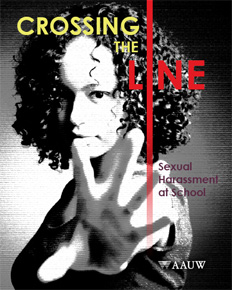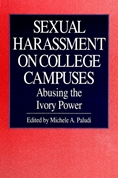“Why does sexual harassment persist despite nearly three decades of attempts to eliminate it? While courts have developed a comprehensive set of legal rules governing workplace harassment, the incidence of harassment has not changed. That is true, in part, because the rules of employer liability for harassment are calculated to ensure that employers adopt basic policies and procedures with respect to workplace harassment, not, surprisingly, to ensure that they actually prevent it. In both legal and extralegal discourse little or no attempt has been made to connect the legal regime to the actual problem of harassment. This Article remedies this inattention by reevaluating legal regime in light of an emerging body of social science literature addressing the causes of harassment, the effectiveness of various preventative measures, and the substantive and procedural adequacy of internal grievance procedures.”
Mary Ann Case, Disaggregating Gender From Sex and Sexual Orientation: The Effeminate Man in the Law and Feminist Jurisprudence, 105 Yale L.J. 1 (1995)
Catherine Hill and Holly Kearl, Crossing the Line: Sexual Harassment at School (2011)

Catherine Hill & Holly Kearl, AAUW, Crossing the Line: Sexual Harassment at School (2011)
“Based on a survey of a nationally representative sample of 1,965 students conducted in May and June 2011, Crossing the Line: Sexual Harassment at School presents the most comprehensive research to date on sexual harassment in grades 7–12. The report reveals some sobering statistics about the prevalence of sexual harassment and the negative impact it has on students’ education. It concludes with concrete recommendations and promising practices for preventing sexual harassment directed at school administrators, educators, parents, students, and community members. We hope readers will be inspired to take new steps toward making schools free from sexual harassment.”
Sexual Harassment on College Campuses: Abusing the Ivory Power, edited by Michele A. Paludi (1996)

Sexual Harassment on College Campuses: Abusing the Ivory Power, edited by Michele A. Paludi (1996)
An updated and expanded revision of the first edition, which received the Gustavus Myers Center Award for an outstanding book on Human Rights in the United States. Intended for administrators and faculty, it is also a resource book for individuals wanting to make changes in their campus’ policy and procedures with regard to sexual harassment.
Jodi Kantor and Megan Twohey, She Said: Breaking the Sexual Harassment Story that Helped Ignite
New York Times investigative journalists Jodi Kantor and Megan Twohey have published She Said: Breaking the Sexual Harassment Story that Helped Ignite the Movement about their investigation and its consequences for the #MeToo movement.
Carlotta J. Ross, DiCenso v. Cisneros: An Argument for Recognizing the Sanctity of the Home in Housing Sexual Harassment Cases
Sexual harassment, commonly associated with the workplace or classroom, also frequently occurs in the home. Unlike in employment or academic settings, sexual harassment in housing is a relatively undeveloped area of jurisprudence. Only recently have the courts confronted a steadily increasing demand to address matters of sexual harassment in housing. Notably, every court that has been faced with the question of whether sexual harassment is actionable under Title VIII has answered affirmatively.’ Following this trend, in DiCenso v. Cisneros, the United States Court of Appeals for the Seventh Circuit held that hostile environment sexual harassment claims are actionable under the Fair Housing Act.’ The court further held, however, under the de novo standard of review, that this particular tenant’s claim “was not sufficiently egregious.” The court relied on Title VII legal theories, as is common in Title VIII cases. That is, the court treated this housing sexual harassment case as the equivalent of an employment sexual harassment case. This comment reflects upon housing sexual harassment jurisprudence and ultimately questions the common practice of applying Title VII law to Title VIII cases.
Recommended Citation: Carlotta J. Ross, DiCenso v. Cisneros: An Argument for Recognizing the Sanctity of the Home in Housing Sexual Harassment Cases, 52 U. Miami L. Rev. 1131 (1998) Available at: http://repository.law.miami.edu/umlr/vol52/iss4/9
Robert G. Schwemm & Rigel C. Oliveri, A New Look at Sexual Harassment under the Fair Housing Act: The Forgotten Role of §3604(c)
Sexual harassment in housing is a significant national problem. Although less visible than the comparable problem in employment, sexual harassment in housing may be as prevalent and probably more devastating to its victims. Nevertheless, relatively little attention has been paid to this issue or to the law that should govern it. Indeed, the law of sexual harassment in housing developed well after and in virtual lock -step with the law of sexual harassment in employment. Thus, courts have simply interpreted the Fair Housing Act (FHA) to prohibit sexual harassment to the same degree-and only to the same degree-as it is prohibited in employment by Title VII of the 1964 Civil Rights Act. This is inappropriate. It is true that the FHA contains a “terms and conditions” provision that parallels the one in Title VII that has been the key to sexual harassment law in employment. But the FHA also contains an additional provision-§ 3604(c)-that bans sexually discriminatory statements in a way that goes well beyond its Title VII counterpart. The availability of § 3604(c) as an additional weapon in the arsenal against sexual harassment in housing-and its lack of use by courts and litigants is the subject of this Article.
Recommended Citation: Robert G. Schwemm & Rigel C. Oliveri, A New Look at Sexual Harassment under the Fair Housing Act: The Forgotten Role of § 3604(c), 2002 Wis. L. Rev. 771 (2002).
Griff Tester, An Intersectional Analysis of Sexual Harassment in Housing
Research on sexual harassment in the workplace is extensive, yet research on sexual harassment in housing is extremely limited. In this study, the author qualitatively analyzes 60 cases of sexual harassment in rental housing to expand on recent research addressing this topic by examining the forms and processes of housing-related sexual harassment in more detail, with a particular focus on class and race. This study reveals that sexual coercion is the most common form of sexual harassment for women in housing. It also demonstrates the intersections of race, gender, and class in shaping this harassment. Landlords used their institutional authority in the housing context and racialized gender stereotypes to exploit tenants’ economic vulnerabilities and sexually coerce them. Landlords also used these strategies to defend themselves against complaints of harassment.
Tester, G. (2008). An Intersectional Analysis of Sexual Harassment in Housing. Gender & Society, 22(3), 349–366. https://doi.org/10.1177/0891243208317827
Rigel C. Oliveri, Sexual Harassment of Low-Income Women in Housing: Pilot Study Results
Abstract
In recent months, high-profile and influential figures in media, government, and entertainment have been brought down by credible allegations that they have engaged in sexual misconduct. These revelations have sparked an important national discussion about the prevalence of sexual harassment in American society and the ways in which powerful people can use their positions both to exploit their vulnerable targets and to escape the consequences of their actions.
The conversation is a necessary starting point, but the focus on high-status workplaces overlooks other contexts in which sexual harassment occurs. This Article focuses on one overlooked, significant national problem: the sexual harassment and exploitation of low-income women by their landlords. Many published cases have dealt with the phenomenon, and the Department of Justice (“DOJ”) has filed many complaints against alleged harassers. Good academic articles in legal and social science literature also exist that discuss the subject from a largely theoretical perspective.4 But something crucial is missing: data. Unlike sexual harassment in the workplace, which has been exhaustively studied by academics of every stripe, there have been no reliable empirical studies about the nature and prevalence of sexual harassment in housing.
Recommended Citation
Rigel C. Oliveri, Sexual Harassment of Low-Income Women in Housing: Pilot Study Results, 83 Missouri Law Review 597 (2018).
Available at: https://scholarship.law.missouri.edu/facpubs/721
Race-ing Justice, En-Gendering Power: Essays on Anita Hill, Clarence Thomas, and the Construction of Social Reality, edited by Toni Morrison (1993)
“It was perhaps the most wretchedly aspersive race and gender scandal of recent times: the dramatic testimony of Anita Hill at the Senate hearings on the confirmation of Clarence Thomas as Supreme Court Justice. Yet even as the televised proceedings shocked and galvanized viewers not only in this country but the world over, they cast a long shadow on essential issues that define America.
In Race-ing Justice, En-gendering Power, Toni Morrison contributes an introduction and brings together eighteen provocative essays, all but one written especially for this book, by prominent and distinguished academicians—black and white, male and female. These writings powerfully elucidate not only the racial and sexual but also the historical, political, cultural, legal, psychological, and linguistic aspects of a signal and revelatory moment in American history.
With contributions by:
Homi K. Bhabha, Margaret A. Burnham, Kimberlé Crenshaw, Paula Giddings, A. Leon Higginbotham, Jr., Claudia Brodsky Lacour, Wahneema Lubiano, Manning Marable, Nellie Y. McKay, Toni Morrison, Nell Irvin Painter, Gayle Pemberton, Andrew Ross, Christine Stansell, Carol M. Swain, Michael Thelwell, Kendall Thomas, Cornel West, Patricia J. Williams”


